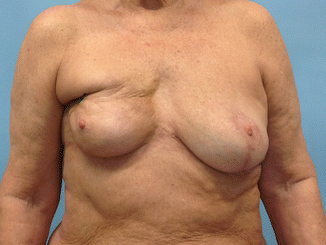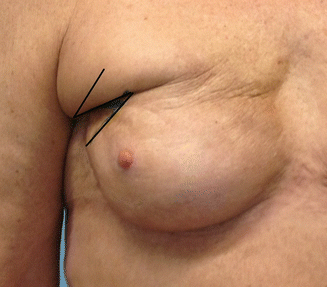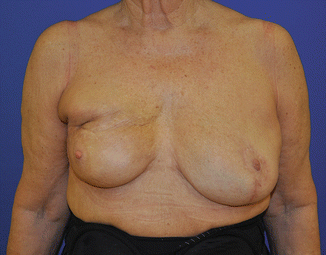Fig. 54.1
View of breast asymmetry after two tumourectomies from the right breast and radiotherapy 1 month after 200 cc of lipofilling and reduction of the left breast

Fig. 54.2
Six months after Fig. 54.1 and 7 months after initial lipomodelling with marked volume loss and persisting scar contracture

Fig. 54.3
The design of the Z-plasty is shown
54.3 (Clinical and Cosmetic) Outcome
The postoperative course was uneventful after both operations. Nevertheless, our efforts did not result in a major improvement. The final result showed a gain in volume, but a complete release of the contracted scar and a filling of the defect could not be achieved due to recurrent scar contracture in the double irradiated breast (Fig. 54.4).


Fig. 54.4
Result after 120 cc lipofilling and Z-plasty with improvement of the contracture but lack of complete release
54.4 Comments of the Author
Local problems after breast-conserving therapy (BCT) have been described since its introduction in the therapy of breast cancer (Berrino et al. 1987). Until several years ago the transfer of autologous flaps from the back or the abdomen was the method of choice to deal with breast deformities after BCT. Recently lipofilling was advocated to be a reasonable method for the correction of breast deformities caused by partial mastectomy.
Autologous fat transfer was successfully applied to fill local volume defects after BCT and in breast augmentation for aesthetic reasons (SaintCyr et al. 2012; Zheng et al. 2008; Largo et al. 2014). On the other hand, single cases of total breast reconstruction were described although they needed many operative sessions (Khouri et al. 2014). Furthermore, large series for the application of lipomodelling of residual defects after total breast reconstruction with flaps and for the correction of post-radiation sequelae are existing (Delay 2011; Rigotti et al. 2007).
The oncologic safety of this method has been discussed extensively (Loshiriwat et al. 2011). Although an influence of the transplanted cells on tumour growth is still under discussion, retrospective studies showed no significant increase in locoregional recurrences (Rietjens et al. 2011; Petit et al. 2011; Largo et al. 2014; Claro et al. 2012). A recent prospective study revealed an 18 % incidence of tumour recurrence in lipofillings after ductal in situ neoplasias (Petit et al. 2013). Therefore, a time interval between breast-conserving operation and lipofilling of at least 2 years is recommended.
Although a higher incidence of repeated injections after radiotherapy was reported (Losken et al 2011), evidence-based studies of the potentials of this method to fill the contracted scarred type III defects (Slavin 2011




Stay updated, free articles. Join our Telegram channel

Full access? Get Clinical Tree








